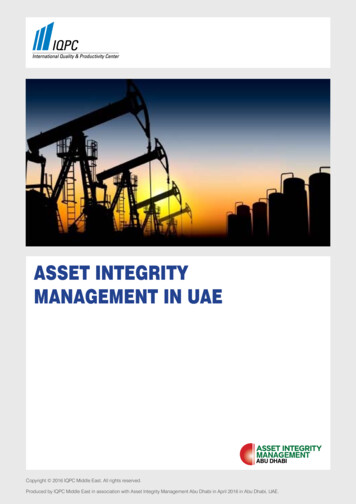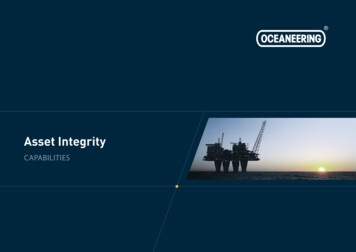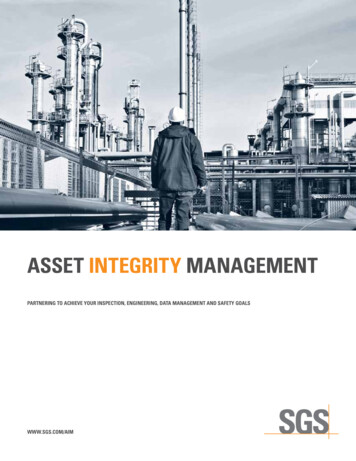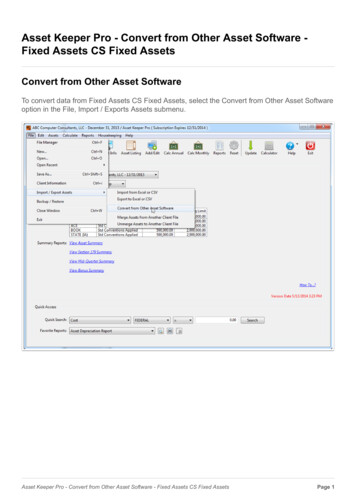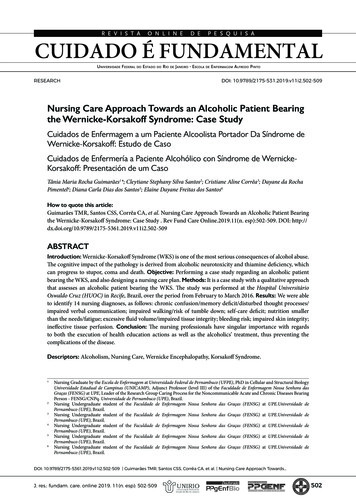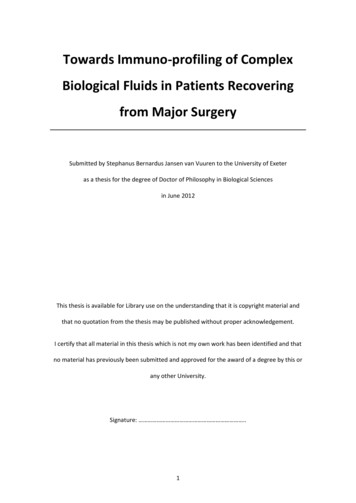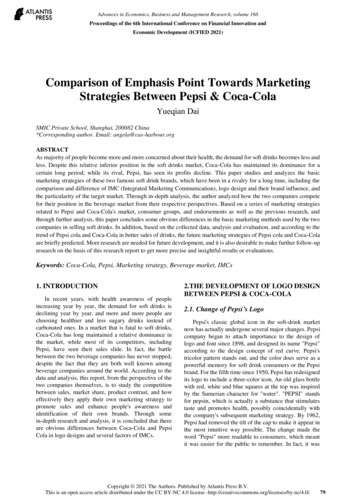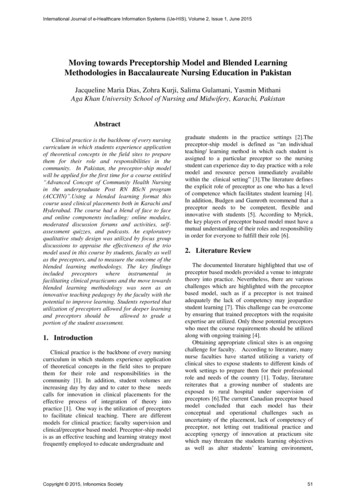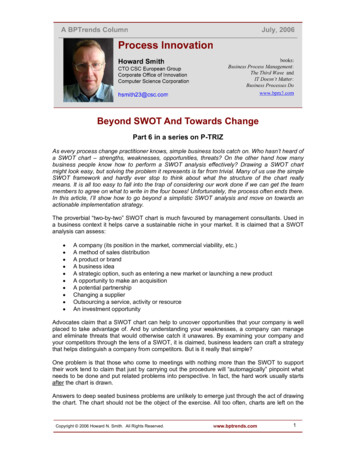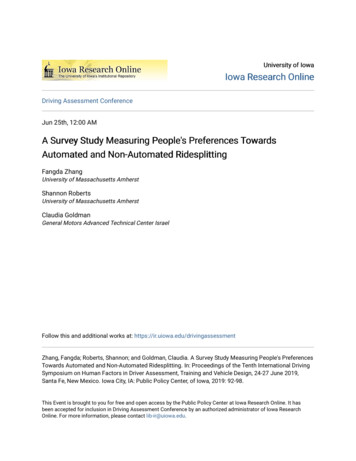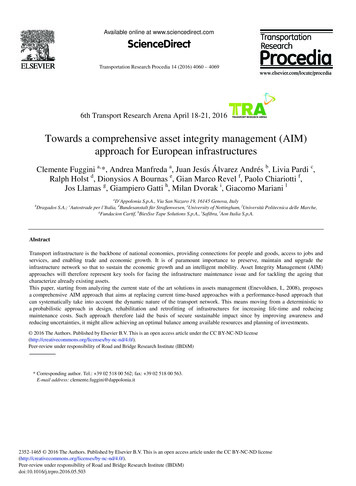
Transcription
Available online at www.sciencedirect.comScienceDirectTransportation Research Procedia 14 (2016) 4060 – 40696th Transport Research Arena April 18-21, 2016Towards a comprehensive asset integrity management (AIM)approach for European infrastructuresClemente Fuggini a, *, Andrea Manfreda a, Juan Jesús Álvarez Andrés b, Livia Pardi c,Ralph Holst d, Dionysios A Bournas e, Gian Marco Revel f, Paolo Chiariotti f,Jos Llamas g, Giampiero Gatti h, Milan Dvorak i, Giacomo Mariani laD’Appolonia S.p.A., Via San Nazaro 19, 16145 Genova, ItalyDragados S.A.; cAutostrade per l’Italia, dBundesanstalt für Straßenwesen, eUniversity of Nottingham, fUniversità Politecnica delle Marche,gFundacion Cartif, hBiesSse Tape Solutions S.p.A., iSafibra, lAon Italia S.p.A.bAbstractTransport infrastructure is the backbone of national economies, providing connections for people and goods, access to jobs andservices, and enabling trade and economic growth. It is of paramount importance to preserve, maintain and upgrade theinfrastructure network so that to sustain the economic growth and an intelligent mobility. Asset Integrity Management (AIM)approaches will therefore represent key tools for facing the infrastructure maintenance issue and for tackling the ageing thatcharacterize already existing assets.This paper, starting from analyzing the current state of the art solutions in assets management (Enevoldsen, I., 2008), proposesa comprehensive AIM approach that aims at replacing current time-based approaches with a performance-based approach thatcan systematically take into account the dynamic nature of the transport network. This means moving from a deterministic toa probabilistic approach in design, rehabilitation and retrofitting of infrastructures for increasing life-time and reducingmaintenance costs. Such approach therefore laid the basis of secure sustainable impact since by improving awareness andreducing uncertainties, it might allow achieving an optimal balance among available resources and planning of investments. 2016 The Authors. Published by Elsevier B.V. This is an open access article under the CC BY-NC-ND license 2016The Authors. Published by Elsevier 4.0/).Peer-review under responsibility of Road and Bridge Research Institute (IBDiM).Peer-review under responsibility of Road and Bridge Research Institute (IBDiM)* Corresponding author. Tel.: 39 02 518 00 562; fax: 39 02 518 00 563.E-mail address: clemente.fuggini@dappolonia.it2352-1465 2016 The Authors. Published by Elsevier B.V. This is an open access article under the CC BY-NC-ND nd/4.0/).Peer-review under responsibility of Road and Bridge Research Institute (IBDiM)doi:10.1016/j.trpro.2016.05.503
Clemente Fuggini et al. / Transportation Research Procedia 14 (2016) 4060 – 4069Keywords: Performance-based design; asset integrity management; self-monitoring, decision support1. IntroductionTransport infrastructure is much more than asphalt, concrete or steel; it is the backbone of nationaleconomies, providing connections for people and goods, access to jobs and services, and enabling trade andeconomic growth (International Transport Forum 2013). This highlights the role of infrastructures as one of the mainpillars of European society. However, infrastructures suffer from ageing (as they are approaching the end-of-life)and increased fatigue issues (vehicle weights and traffic increased over time). Bridges (Sustainable Bridges) andtunnels are relevant infrastructures suffering of these problems (Vienna Consulting Engineers). Although positivetrends (e.g. improvements) in the health status of infrastructures (bridges and tunnels in particular) have beendemonstrated across Europe, for instance in Italy, Spain and in Germany (see the Condition Index (CI) in Figure 1)Investments on infrastructures have been dramatically decreases in the same time frame (e.g. 2001-2011). Given thefact that bridges constitute the 90% of the total assets of all engineering structures in Germany (valued at approx.50B ) and that Italian tunnels represent 70% of the whole European tunnel network, the situation requires a longterm and effective strategy.Nowadays Germany estimates a budget allocation of respectively 300-500M (Federal Ministry of Transport inGermany) for maintenance of more than 40000 bridges/tunnels, and in Italy, Autostrade per l’Italia estimates anallocation of more than 40M (Factbook) a year for more than 4000 bridges and tunnels. These investments are to beused in the most effective way to guarantee a correct and lasting maintenance to assure the survival and upgrade ofthe infrastructure. However, the efficiency of such investments depends on the type of inspections and interventionsthat are planned/actuated on a time-basis, which could result in extra-costs. Moreover, it may be envisaged that dueto the actual economic situation, less financial resources would be available in the future: in order to properly handlethe ageing infrastructures, a different management approach is needed. This, combined with the fact that the costs ofnew European infrastructures is costly more than maintaining the existing network, brings to the point that Europecan have an healthy, available and usable transport infrastructures network, mainly by preserving and prolonging thelife-time of the existing network. Indeed, upgrading the existing infrastructure is in many cases the cheapest way toenhance the overall performance of the transport system (A sustainable future for transport, 2009).In this scenario, visual inspections can be significantly improved using non-destructive test methods or StructuralHealth Monitoring (SHM) techniques. Continuous data allows a better assessment of a structure performance and animproved prediction of its durability and remaining life time. Data can be then used to trigger inspectionautonomously and based on the current performance. More precise data will make possible a recalculation ofstructures capacity and a compliance with guidelines (Federal Ministry of Transport in Germany) that, validated inpioneering countries like Germany, may become standards in Europe.Fig. 1. Example of Condition Index for Bridges in Germany (Federal Ministry of Transport in Germany).4061
4062Clemente Fuggini et al. / Transportation Research Procedia 14 (2016) 4060 – 40692. Asset Integrity Management of Transport InfrastructuresWithin this context, it is clear the need to move from current time-based approach in Asset Integrity Management(AIM) to performance-based approach that can systematically take into account the dynamic nature of the transportnetwork to be used in the management (design, repair, etc.) and maintenance planning of infrastructures. This meansmoving from a deterministic to a probabilistic approach in design, rehabilitation and retrofitting of infrastructures toincrease their life-time and reduce maintenance costs, taking the “risk” element or the “risk-based analysis” asprimary driver. To achieve this overall objective, an analysis of the current solutions available for AIM is needed inorder to understand where the progress beyond current State of the Art (SoA) are mainly required and thereforefocus the research activities and investments in a certain direction. The following table reports the results of thisanalysis by comparing the features and characteristics provided by standards and commercially available AIMsystem vs. the requirements or better the desiderata from the industrial sector (Infrastructure Assets CodeConsultation Document) and the stakeholders involved in the infrastructure sector. Most of commercially availableAIM systems mainly rely on the management of physical assets permitting their ability to perform requiredfunctions, basin the assessment of future asset integrity on the past and without the introduction of mitigationmeasures that account for the adoption of risk-based solutions.Among the others, the following AIM systems have been considered for comparison: Intertek solution for civilinfrastructure (taken as reference for specific and advanced AIM tools); SAP solution (taken as worldwide industrialreference of AIM) and finally the AIM tool for structures by Bureau Veritas (taken as reference for tools provided bycertifying bodies). Although these tools are commercial ones, in most of the cases, they do not include all industrialinputs, do not have risk-based approach and finally do need customizations according to the type of infrastructureselected. Therefore there is the need for solutions that account for the specific dynamism of the transportinfrastructures, there is the need for the development of additional services to ensure network continuity minimizingmaintenance and optimizing repairs, and the need for the use of predictive analytical models for the assessment ofthe future asset performance.Table 1. Features and Characteristics of current AIM solutions vs. Industrial Requirements.FeaturesIndustrial RequirementsIntertekLife extension & design updateYesYesSAPBureau VeritasRegulatory complianceYesCertifications & VerificationsYesYesYesYesYesYesRisk Based AnalysisYesRisk Based DesignYesYesYesFinancial AnalysisYesYesProbabilistic loss analysis & Risk transferYesYesBusiness continuityPreferredYesYesYesYes3. Proposed ConceptWithin this framework, the primary objective of any future advanced AIM solution should be to keep an asset in afit-for-service condition while extending its remaining life in the most reliable, safe, and cost-effective way. This isachieved by combining Design, Engineering and Operational Integrity. The Oil & Gas sector for instance hasimplemented this approach since many years. However, the transfer of this approach to the infrastructure sector isnot so straightforward. Indeed, while the Oil & Gas sector can be considered quasi-static (processes involved aresubjected to slow-varying constraints), the world of transport networks is highly dynamic during its life-time(boundary conditions can vary). To make this possible and effective, performance-based methods need to beaccounted for, as they allow characterizing all the variables involved in system design as probabilistic variables,evolving according to a specified Probability Density Functions (PDFs). This means moving from a deterministicapproach (allowable stress) to a probabilistic approach in the design, repair and maintenance of the infrastructure as
Clemente Fuggini et al. / Transportation Research Procedia 14 (2016) 4060 – 40694063depicted in Figure 2. An investigation of the feasibility of this approach has been already proposed by Neumann T.,2012.Core of the analysis is the construction of the probabilistic evaluation that an encountered load (L) may exceedthe ability of the structure (resistance R) to carry that load, represented by the overlapping portion of the PDF curves.The probability that L exceed R represents the failure state of the system or Pfail; this can be preliminary estimatedvia the calculation of a reliability index (I) or in a fully probabilistic approach (e.g. Montecarlo simulations) wherethe solution is found through iteratively random generated simulations to determine those which fall into the limitstate domain. Inspections and monitoring can provide in-service data (at both micro and macro scale level) andstatistical information that help in accurately estimating, over the life-time of the infrastructure, the PDF of R and Land in predicting their future evolution. The main advantages in adopting such approach will be:x Characterization of the variables/parameters involved in the calculation (for design and repair) of a structuralsystem as probabilistic variables/parameters, evolving according to specified PDFsx Reduction of uncertainty and variability of design across infrastructure lifetime (Life Cycle Approach)x Optimization of repair design to deliver improved solutionsx Adoption of condition-based and predictive maintenance logics by leveraging on the use of data from inspectionsand monitoring in probabilistic analysesx More precise estimation of failure models (and their effects) of a structural systemFig. 2. Overall concept: moving from deterministic to performance based design principles.This transition is clearly shown in the Figure 3, moving from the Step 0 (current situation) to a probabilisticapproach (Step1) as short term solution up to a predictive approach in AIM as a long-term perspective. Changes areneeded and there are opportunistic if we want to keep the same or even higher performance and availability of thetransport network in the future considering an ageing infrastructure and an increase in demand.
4064Clemente Fuggini et al. / Transportation Research Procedia 14 (2016) 4060 – 4069Fig. 3. Transition from a conventional to an advanced futuristic approach.For instance, when it comes to “repair design”, it is of paramount importance to achieve a better understanding ofdegradation and ageing processes and to reduce disruption caused by network congestion (The reFINE Roadmap,2013). Solutions for sustainable and durable retrofitting of assets that are based on new low environmental impactmaterials are part of the strategy. Indeed, application of conventional retrofitting techniques, such as steel or concretejacketing require intensive labour (high cost) and considerable quantities of materials (higher embodied CO2emissions and energy), and significantly disrupt the traffic of the infrastructure asset under renovation. To overcomethese issues, advanced materials are required. One of today’s SoA techniques is the use of fibre reinforced polymers(FRPs). Despite their well-established advantages (high strength, corrosion resistance, ease and speed ofapplication), the FRP strengthening technique entails a few drawbacks (poor behaviour at high temperatures, highcosts, inapplicability on wet surfaces, etc.). To address the problems of FRPs,
Asset Integrity Management (AIM) approaches will therefore represent key tools for facing the infrastructure maintenance issue and for tackling the ageing that characterize already existing assets. This paper, starting from analyzing the current state of the art solutions in assets management (Enevoldsen, I., 2008), proposes
